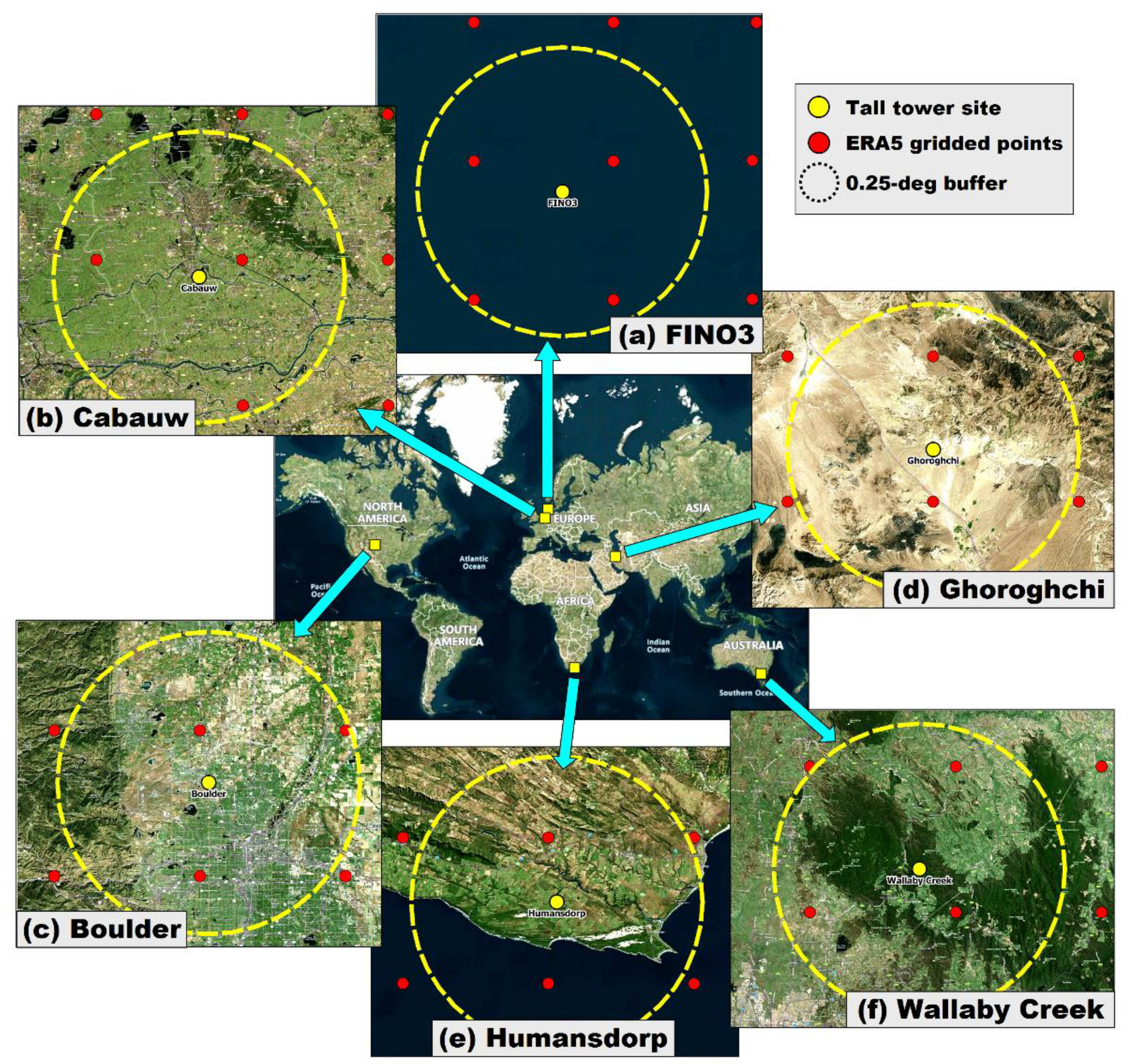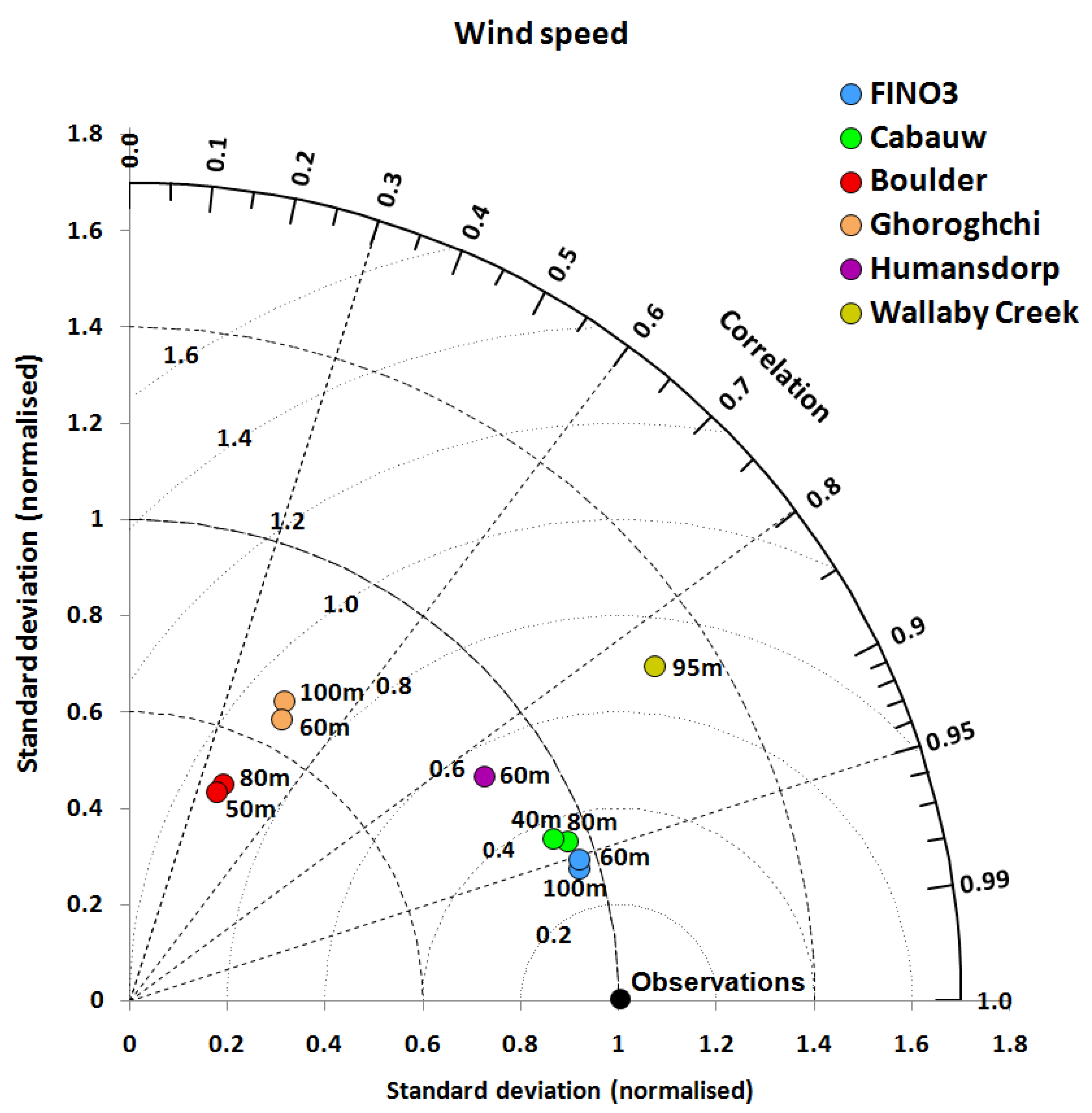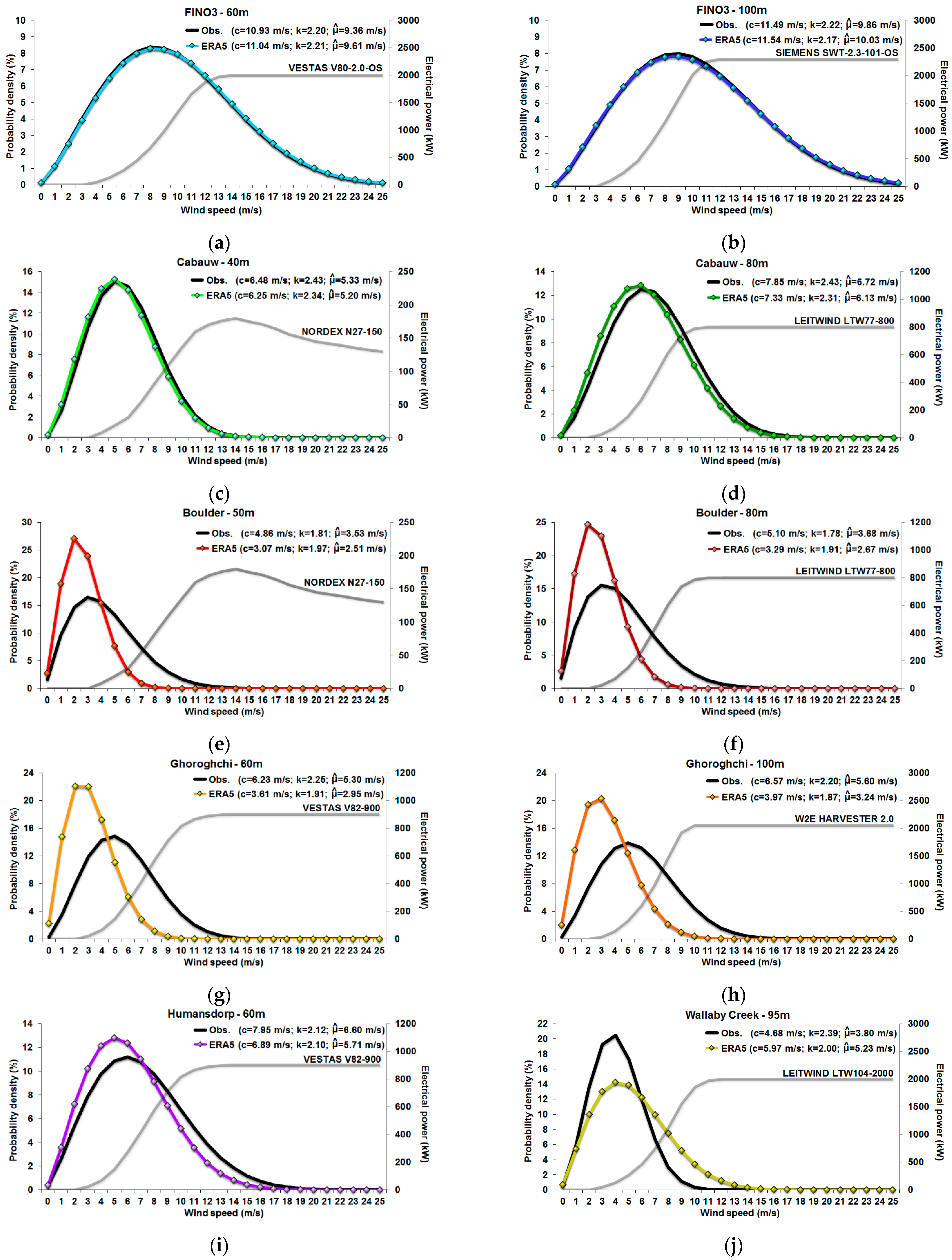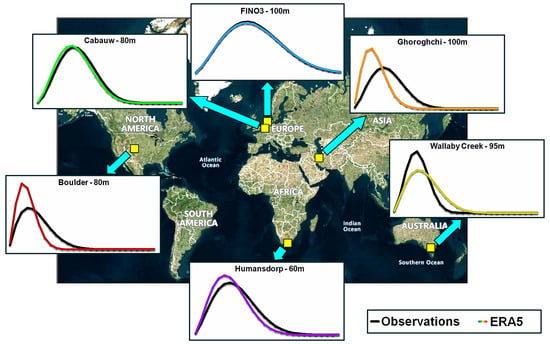Reliability of ERA5 Reanalysis Data for Wind Resource Assessment: A Comparison against Tall Towers
Abstract
:1. Introduction
2. Materials and Methods
2.1. Wind Resource and Wind Power Output
2.2. Variables Vertical Profiles
2.3. ERA5 Reanalysis
2.4. The Tall Tower Dataset
2.5. Study Sites
2.6. Selected ERA5 and Tall Tower Meteorological Data
2.7. Selected ERA5 Geophysical Data
3. Results
3.1. Wind Speed and Air Density
3.2. Wind Speed Weibull Distribution
3.3. Wind Energy Production
4. Discussion
4.1. Wind Speed
4.2. Wind Energy Production
5. Conclusions
Supplementary Materials
Funding
Data Availability Statement
Conflicts of Interest
References
- Calif, R.; Schmitt, F.G.; Huang, Y. Multifractal description of wind power fluctuations using arbitrary order Hilbert spectral analysis. Phys. A Stat. Mech. Its Appl. 2013, 392, 4106–4120. [Google Scholar] [CrossRef]
- Aboobacker, V.M.; Shanas, P.R.; Veerasingam, S.; Al-Ansari, E.M.; Sadooni, F.N.; Vethamony, P. Long-term assessment of onshore and offshore wind energy potentials of Qatar. Energies 2021, 14, 1178. [Google Scholar] [CrossRef]
- Floors, R.; Nielsen, M. Estimating air density using observations and re-analysis outputs for wind energy purposes. Energies 2019, 12, 2038. [Google Scholar] [CrossRef] [Green Version]
- Gryning, S.E.; Floors, R. Investigating predictability of offshore winds using a mesoscale model driven by forecast and reanalysis data. Meteorol. Z. 2020, 29, 117–130. [Google Scholar] [CrossRef]
- Wahl, S.; Bollmeyer, C.; Crewell, S.; Figura, C.; Friederichs, P.; Hense, A.; Keller, J.D.; Ohlwein, C. A novel convective-scale regional reanalysis COSMO-REA2: Improving the representation of precipitation. Meteorol. Z. 2017, 26, 345–361. [Google Scholar] [CrossRef]
- Ridal, M.; Olsson, E.; Unden, P.; Zimmermann, K.; Ohlsson, A. Uncertainties in Ensembles of Regional Re-Analyses. Deliverable D2.7 HARMONIE Reanalysis Report of Results and Dataset 2017. Available online: http://www.uerra.eu/component/dpattachments/?task=attachment.download&id=296 (accessed on 11 June 2021).
- Bazile, E.; Abida, R.; Szczypta, C.; Verelle, A.; Soci, C.; Le Moigne, P. MESCAN-SURFEX Surface Analysis. Deliverable D2.9 of the UERRA Project 2017. Available online: http://www.uerra.eu/publications/deliverable-reports.html (accessed on 11 June 2021).
- Saha, S.; Moorthi, S.; Wu, X.; Wang, J.; Nadiga, S.; Tripp, P.; Behringer, D.; Hou, Y.-T.; Chuang, H.-Y.; Iredell, M.; et al. The NCEP Climate Forecast System Version 2. J. Clim. 2014, 27, 2185–2208. [Google Scholar] [CrossRef]
- Gelaro, R.; Mccarty, W.; Suárez, M.J.; Todling, R.; Molod, A.; Takacs, L.; Randles, C.A.; Darmenov, A.; Bosilovich, M.G.; Reichle, R.H.; et al. The Modern-Era Retrospective Analysis for Research and Applications, Version 2 (MERRA-2). J. Clim. 2017, 30, 5419–5454. [Google Scholar] [CrossRef] [PubMed]
- Kobayashi, S.; Ota, Y.; Harada, Y.; Ebita, A.; Moriya, M.; Onoda, H.; Onogi, K.; Kamahori, H.; Kobayashi, C.; Endo, H.; et al. The JRA-55 reanalysis: General specifications and basic characteristics. J. Meteorol. Soc. Jpn. 2015, 93, 5–48. [Google Scholar] [CrossRef] [Green Version]
- Hersbach, H.; Bell, B.; Berrisford, P.; Hirahara, S.; Horányi, A.; Muñoz-Sabater, J.; Nicolas, J.; Peubey, C.; Radu, R.; Schepers, D.; et al. The ERA5 global reanalysis. Q. J. R. Meteorol. Soc. 2020, 146, 1999–2049. [Google Scholar] [CrossRef]
- Camargo, L.R.; Gruber, K.; Nitsch, F. Assessing variables of regional reanalysis data sets relevant for modelling small-scale renewable energy systems. Renew. Energy 2019, 133, 1468–1478. [Google Scholar] [CrossRef]
- Skamarock, W.C.; Klemp, J.B.; Dudhia, J.; Gill, D.O.; Barker, D.M.; Wang, W.; Powers, J.G. A Description of the Advanced Research WRF Version 2; National Center For Atmospheric Research Boulder Co Mesoscale and Microscale Meteorology Div: Boulder, CO, USA, 2005. [Google Scholar]
- Global Wind Atlas. Available online: https://globalwindatlas.info/about/introduction (accessed on 11 June 2021).
- Dörenkämper, M.; Olsen, B.T.; Witha, B.; Hahmann, A.N.; Davis, N.N.; Barcons, J.; Ezber, Y.; García-Bustamante, E.; González-Rouco, J.F.; Navarro, J.; et al. The making of the new european wind atlas–part 2: Production and evaluation. Geosci. Model Dev. 2020, 13, 5079–5102. [Google Scholar] [CrossRef]
- Janjai, S.; Masiri, I.; Promsen, W.; Pattarapanitchai, S.; Pankaew, P.; Laksanaboonsong, J.; Bischoff-Gauss, I.; Kalthoff, N. Evaluation of wind energy potential over Thailand by using an atmospheric mesoscale model and a GIS approach. J. Wind. Eng. Ind. Aerodyn. 2014, 129, 1–108. [Google Scholar] [CrossRef]
- ECMWF Reanalysis v5 (ERA5). Available online: https://www.ecmwf.int/en/forecasts/dataset/ecmwf-reanalysis-v5 (accessed on 11 June 2021).
- Climate Data Store. Available online: https://cds.climate.copernicus.eu (accessed on 11 June 2021).
- Olauson, J. ERA5: The new champion of wind power modelling? Renew. Energy 2018, 126, 322–331. [Google Scholar] [CrossRef] [Green Version]
- Gualtieri, G. Improving investigation of wind turbine optimal site matching through the self-organizing maps. Energy Convers. Manag. 2017, 143, 295–311. [Google Scholar] [CrossRef] [Green Version]
- Soares, P.M.; Lima, D.C.; Nogueira, M. Global offshore wind energy resources using the new ERA-5 reanalysis. Environ. Res. Lett. 2020, 15, 1040a2. [Google Scholar] [CrossRef]
- Ulazia, A.; Nafarrate, A.; Ibarra-Berastegi, G.; Sáenz, J.; Carreno-Madinabeitia, S. The consequences of air density variations over Northeastern Scotland for offshore wind energy potential. Energies 2019, 12, 2635. [Google Scholar] [CrossRef] [Green Version]
- Ibarra-Berastegi, G.; Ulazia, A.; Saénz, J.; González-Rojí, S.J. Evaluation of Lebanon’s offshore-wind-energy potential. J. Mar. Sci. Eng. 2019, 7, 361. [Google Scholar] [CrossRef] [Green Version]
- Tavares, L.F.D.; Shadman, M.; Assad, L.P.D.; Silva, C.; Landau, L.; Estefen, S.F. Assessment of the offshore wind technical potential for the Brazilian Southeast and South regions. Energy 2020, 196, 117097. [Google Scholar] [CrossRef]
- Soukissian, T.H.; Karathanasi, F.E.; Zaragkas, D.K. Exploiting offshore wind and solar resources in the Mediterranean using ERA5 reanalysis data. Energy Convers. Manag. 2021, 237, 114092. [Google Scholar] [CrossRef]
- Farjami, H.; Hesari, A.R.E. Assessment of sea surface wind field pattern over the Caspian Sea using EOF analysis. Reg. Stud. Mar. Sci. 2020, 35, 101254. [Google Scholar] [CrossRef]
- Kumar, V.S.; Asok, A.B.; George, J.; Amrutha, M.M. Regional Study of Changes in Wind Power in the Indian Shelf Seas over the Last 40 Years. Energies 2020, 13, 2295. [Google Scholar] [CrossRef]
- Jurasz, J.; Mikulik, J.; Dąbek, P.B.; Guezgouz, M.; Kaźmierczak, B. Complementarity and ‘Resource Droughts’ of Solar and Wind Energy in Poland: An ERA5-Based Analysis. Energies 2021, 14, 1118. [Google Scholar] [CrossRef]
- Nefabas, K.L.; Söder, L.; Mamo, M.; Olauson, J. Modeling of Ethiopian Wind Power Production Using ERA5 Reanalysis Data. Energies 2021, 14, 2573. [Google Scholar] [CrossRef]
- Ruiz, S.A.G.; Barriga, J.E.C.; Martínez, J.A. Wind power assessment in the Caribbean region of Colombia, using ten-minute wind observations and ERA5 data. Renew. Energy 2021, 172, 158–176. [Google Scholar] [CrossRef]
- Jourdier, B. Evaluation of ERA5, MERRA-2, COSMO-REA6, NEWA and AROME to simulate wind power production over France. Adv. Sci. Res. 2020, 17, 63–77. [Google Scholar] [CrossRef]
- Justus, C.G.; Hargraves, W.R.; Yalcin, A. National assessment of potential output from wind-powered generators. J. Appl. Meteorol. 1976, 15, 673–678. [Google Scholar] [CrossRef] [Green Version]
- Chang, T.J.; Wu, Y.T.; Hsu, H.Y.; Chu, C.R.; Liao, C.M. Assessment of wind characteristics and wind turbine characteristics in Taiwan. Renew. Energy 2003, 28, 851–871. [Google Scholar] [CrossRef]
- Chen, J.; Wang, F.; Stelson, K.A. A mathematical approach to minimizing the cost of energy for large utility wind turbines. Appl. Energy 2018, 228, 1413–1422. [Google Scholar] [CrossRef]
- Drew, D.R.; Barlow, J.F.; Lane, S.E. Observations of wind speed profiles over Greater London, UK, using a Doppler lidar. J. Wind. Eng. Ind. Aerodyn. 2013, 121, 98–105. [Google Scholar] [CrossRef] [Green Version]
- Stull, R. Practical Meteorology: An Algebra-Based Survey of Atmospheric Science; University of British Columbia: Vancouver, BC, Canada, 2015; pp. 8, 70. ISBN 978-0-88865-176-1. [Google Scholar]
- Hersbach, H.; Bell, B.; Berrisford, P.; Biavati, G.; Horányi, A.; Muñoz Sabater, J.; Nicolas, J.; Peubey, C.; Radu, R.; Rozum, I.; et al. ERA5 hourly data on single levels from 1979 to present. In Copernicus Climate Change Service (C3S) Climate Data Store (CDS); 14/06/2018; Available online: https://cds.climate.copernicus.eu/cdsapp#!/dataset/reanalysis-era5-single-levels?tab=overview (accessed on 1 June 2021). [CrossRef]
- ECMWF. Newsletter No. 152—Summer 2017. 39, pp. 36–39. Available online: https://www.ecmwf.int/sites/default/files/elibrary/2017/17439-newsletter-no-152-summer-2017.pdf (accessed on 11 June 2021). [CrossRef]
- Ramon, J.; Lledó, L.; Pérez-Zanón, N.; Soret, A.; Doblas-Reyes, F.J. The Tall Tower Dataset: A unique initiative to boost wind energy research. Earth Syst. Sci. Data 2020, 12, 429–439. [Google Scholar] [CrossRef] [Green Version]
- Ramon, J.; Lledó, L. The Tall Tower Dataset. Latest Version: 07/01/2021. Available online: https://b2share.eudat.eu/records/3ac9362f1cee49178236c9e03aec884d (accessed on 11 June 2021).
- Gualtieri, G. Surface turbulence intensity as a predictor of extrapolated wind resource to the turbine hub height: Method’s test at an offshore site. Renew. Energy 2017, 111, 175–186. [Google Scholar] [CrossRef]
- Gottschall, J.; Dörenkämper, M. Understanding and mitigating the impact of data gaps on offshore wind resource estimates. Wind. Energy Sci. 2021, 6, 505–520. [Google Scholar] [CrossRef]
- Gualtieri, G. Wind resource extrapolating tools for modern multi-MW wind turbines: Comparison of the Deaves and Harris model vs. the power law. J. Wind. Eng. Ind. Aerodyn. 2017, 170, 107–117. [Google Scholar] [CrossRef]
- Van den Berg, G.P. Wind turbine power and sound in relation to atmospheric stability. Wind. Energy 2008, 11, 151–169. [Google Scholar] [CrossRef]
- Jager, D.; Andreas, A. NREL National Wind Technology Center (NWTC): M2 Tower; Boulder, Colorado (Data); NREL Report No. DA-5500-56489; National Renewable Energy Lab.(NREL): Golden, CO, USA, 1996. [CrossRef]
- Gualtieri, G. Surface turbulence intensity as a predictor of extrapolated wind resource to the turbine hub height: Method’s test at a mountain site. Renew. Energy 2018, 120, 457–467. [Google Scholar] [CrossRef]
- Mortensen, N.G.; Hansen, J.C.; Kelly, M.C.; Prinsloo, E.; Mabille, E.; Szewczuk, S. Wind Atlas for South Africa (WASA). Western Cape and parts of Northern and Eastern Cape. Station and Site Description Report. Tech. Rep. April 2014. Available online: https://orbit. dtu. dk/ws/files/110948908/DTU_Wind_Energy_E_0072. pdf (accessed on 1 June 2021).
- OzFlux: Australian and New Zealand Flux Research and Monitoring. Available online: http://www.ozflux.org.au/monitoringsites/wallabycreek/index.html (accessed on 11 June 2021).
- ECMWF Vegetation Types and Parameter Values. Available online: https://rda.ucar.edu/datasets/ds630.0/docs/ECMWF_vegetation_types.html (accessed on 11 June 2021).
- Bailey, B.H.; McDonald, S.L.; Bernadett, D.W.; Markus, M.J.; Elsholz, K.V. Wind Resource Assessment Handbook: Fundamentals for Conducting a Successful Monitoring Program; (No. NREL/SR-440-22223; ON: DE97000250); National Renewable Energy Lab.: Golden, CO, USA; AWS Scientific, Inc.: Albany, NY, USA, 1997. [Google Scholar]
- Taylor, K.E. Summarizing multiple aspects of model performance in a single diagram. J. Geophys. Res. 2001, 106, 7183–7192. [Google Scholar] [CrossRef]
- Gualtieri, G. Development and application of an integrated wind resource assessment tool for wind farm planning. Int. J. Renew. Energy Res. 2012, 2, 674–685. [Google Scholar]
- Kaiser-Weiss, A.K.; Borsche, M.; Niermann, D.; Kaspar, F.; Lussana, C.; Isotta, F.A.; van den Besselaar, E.; van der Schrier, G.; Undén, P. Added value of regional reanalyses for climatological applications. Environ. Res. Commun. 2019, 1, 071004. [Google Scholar] [CrossRef]
- Dörenkämper, M.; Optis, M.; Monahan, A.; Steinfeld, G. On the Offshore advection of Boundary-Layer Structures and the Influence on Offshore Wind Conditions. Bound. Layer Meteorol. 2015, 155, 459–482. [Google Scholar] [CrossRef]
- Urraca, R.; Huld, T.; Gracia-Amillo, A.; Martinez-de-Pison, F.J.; Kaspar, F.; Sanz-Garcia, A. Evaluation of global horizontal irradiance estimates from ERA5 and COSMO-REA6 reanalyses using ground and satellite-based data. Sol. Energy 2018, 164, 339–354. [Google Scholar] [CrossRef]
- Jiang, H.; Yang, Y.; Wang, H.; Bai, Y.; Bai, Y. Surface Diffuse Solar Radiation Determined by Reanalysis and Satellite over East Asia: Evaluation and Comparison. Remote Sens. 2020, 12, 1387. [Google Scholar] [CrossRef]
- Ramon, J.; Lledo, L.; Torralba, V.; Soret, A.; Doblas-Reyes, F.J. What global reanalysis best represents near-surface winds? Q. J. R. Meteorol. Soc. 2019, 145, 3236–3251. [Google Scholar] [CrossRef] [Green Version]



| Site | Country | Tower’s Operator | Latitude (deg N) | Longitude (deg E) | Altitude (m a.s.l.) | Environment |
|---|---|---|---|---|---|---|
| FINO3 | Germany | BSH | 55.1949 | 7.1583 | <0 | Offshore |
| Cabauw | Netherlands | KNMI | 51.9703 | 4.9262 | −0.7 | Inland |
| Boulder | USA | NWTC | 39.9106 | –105.2348 | 1855 | Mountainous |
| Ghoroghchi | Iran | SATBA | 33.5900 | 51.0000 | 2140 1 | Desert |
| Humansdorp | South Africa | SANEDI | −34.1100 | 24.5144 | 110 | Coastal |
| Wallaby Creek | Australia | Monash University | −37.4262 | 145.1872 | 720 | Forested |
| Site | Height by Variable (m) | Time Period | ||
|---|---|---|---|---|
| Wind Speed 1 | Temperature | Pressure | ||
| ERA5 | ||||
| All | 10, 100 | 2 | 0 | Same as tower data |
| Tall towers | ||||
| FINO3 | 60, 100 | 29, 55, 94 | 23, 94 | 1 January 2014–31 December 2015 |
| Cabauw | 40, 80 | 40, 80 | 0 | 1 January 2014–31 December 2015 |
| Boulder | 50, 80 | 2, 50, 80 | 0 | 1 January 2014–31 December 2015 |
| Ghoroghchi | 60, 100 | 0 | NA | 1 June 2013–31 May 2014 |
| Humansdorp | 60 | 0 | 0 | 1 January 2016–31 December 2016 |
| Wallaby Creek | 95 | 2 | 0 | 1 September 2005–31 August 2006 |
| Site | No. Grid Points | Distance (km) | Altitude (m a.s.l.) | Surface Roughness Length (m) | Low Vegetation | High Vegetation | ||
|---|---|---|---|---|---|---|---|---|
| Cover (%) | Categories | Cover (%) | Categories | |||||
| Aritmetic Mean (Range) | Weighted Mean (Range) | Weighted Mean (Range) | Weighted Mean (Range) | Weighted Mean (Range) | ||||
| FINO3 | 4 | 16.6 (8.8–23.5) | <0 | 0.00 | 100 | Sea | ||
| Cabauw | 3 | 14.5 (5.8–24.9) | −1 (−1–+2) | 0.29 (0.26–0.36) | 92 (86–92) | Crops and mixed farming | 7 (6–13) | Interrupted forest |
| Boulder | 3 | 16.7 (10.2–22.0) | 1992 (1623–2131) | 0.44 (0.12–0.58) | 91 (84–93) | Short grass | 7 (5–16) | Deciduous broadleaf trees |
| Ghoroghchi | 2 | 13.9 (10.0–17.8) | 2054 (2019–2065) | 0.02 | 73 (72–74) | Semidesert | ||
| Humansdorp | 2 | 13.9 (12.3–15.6) | 142 (39–206) | 0.16 (0.15–0.19) | 61 (18–87) | Short grass; Crops and mixed farming | 28 (10–58) | Deciduous broadleaf trees; Interrupted forest |
| Wallaby Creek | 3 | 16.2 (9.4–20.7) | 324 (260–339) | 1.27 (0.48–1.60) | 17 (0–66) | Crops and mixed farming | 82 (34–100) | Interrupted forest; Evergreen broadleaf trees |
| Height (m) | N (%) | Observations | Estimations | Statistical Indicators | ||||||
|---|---|---|---|---|---|---|---|---|---|---|
| µo (m/s) | σo (m/s) | µp (m/s) | σp (m/s) | MB (m/s) | NB | RMSE (m/s) | NRMSE | r | ||
| FINO3 | ||||||||||
| 60 | 15815 (90.27) | 9.50 | 4.43 | 9.49 | 4.27 | 0.01 | 0.00 | 1.35 | 0.14 | 0.95 |
| 100 | 15439 (88.12) | 9.98 | 4.71 | 9.90 | 4.52 | 0.08 | 0.01 | 1.35 | 0.14 | 0.96 |
| Cabauw | ||||||||||
| 40 | 17512 (99.95) | 5.79 | 2.86 | 5.56 | 2.66 | 0.24 | 0.04 | 1.06 | 0.19 | 0.93 |
| 80 | 17511 (99.95) | 6.97 | 3.19 | 6.49 | 3.05 | 0.48 | 0.07 | 1.20 | 0.18 | 0.94 |
| Boulder | ||||||||||
| 50 | 17321 (98.86) | 4.46 | 3.31 | 2.75 | 1.55 | 1.71 | 0.49 | 3.52 | 1.00 | 0.38 |
| 80 | 17321 (98.86) | 4.70 | 3.52 | 2.96 | 1.72 | 1.74 | 0.47 | 3.69 | 0.99 | 0.39 |
| Ghoroghchi | ||||||||||
| 60 | 6267 (71.54) | 5.58 | 2.73 | 3.30 | 1.81 | 2.28 | 0.53 | 3.36 | 0.78 | 0.47 |
| 100 | 6267 (71.54) | 5.86 | 2.82 | 3.62 | 1.97 | 2.25 | 0.49 | 3.44 | 0.75 | 0.45 |
| Humansdorp | ||||||||||
| 60 | 8758 (99.70) | 7.07 | 3.60 | 6.12 | 3.10 | 0.95 | 0.14 | 2.17 | 0.33 | 0.84 |
| Wallaby Creek | ||||||||||
| 95 | 4741 (54.12) | 4.18 | 2.10 | 5.02 | 2.69 | −0.84 | −0.18 | 1.69 | 0.37 | 0.84 |
| Wind Turbine | Observations | Estimations | |||||||
|---|---|---|---|---|---|---|---|---|---|
| Model | Hhub (m) | Pr (kW) | D (m) | Type 3 | AEY (MWh/y) | CF (%) | AEY (MWh/y) | CF (%) | NE (%) |
| FINO3 | |||||||||
| Vestas V80-2.0-OS | 60 | 2000 | 80 | B | 8214 | 46.85 | 8314 | 47.42 | −1.22 |
| Siemens SWT-2.3-101-OS | 101 4 | 2300 | 101 | D | 11468 | 56.88 | 10688 | 53.07 | 6.70 |
| Cabauw | |||||||||
| Nordex N27-150 | 40 | 150 | 27 | A | 337 | 25.66 | 314 | 23.91 | 6.82 |
| Leitwind LTW77-800 | 80 | 800 | 76.7 | D | 3051 | 43.50 | 2880 | 41.08 | 5.56 |
| Boulder | |||||||||
| Nordex N27-150 | 50 | 150 | 17 | A | 148 | 11.22 | 29 | 2.23 | 80.12 |
| Leitwind LTW77-800 | 80 | 800 | 76.7 | D | 1187 | 16.92 | 350 | 4.98 | 70.57 |
| Ghoroghchi | |||||||||
| Vestas V82-900 | 59 5 | 900 | 82 | B | 1602 | 20.30 | 428 | 5.42 | 73.30 |
| W2E Harvester 2.0 | 100 | 2000 | 116 | C | 4406 | 25.13 | 1362 | 7.77 | 69.08 |
| Humansdorp | |||||||||
| Vestas V82-900 | 59 5 | 900 | 82 | B | 3198 | 40.54 | 2532 | 32.09 | 20.84 |
| Wallaby Creek | |||||||||
| Leitwind LTW104-2000 | 95 | 2000 | 104.1 | D | 1730 | 9.87 | 3802 | 21.69 | −119.76 |
Publisher’s Note: MDPI stays neutral with regard to jurisdictional claims in published maps and institutional affiliations. |
© 2021 by the author. Licensee MDPI, Basel, Switzerland. This article is an open access article distributed under the terms and conditions of the Creative Commons Attribution (CC BY) license (https://creativecommons.org/licenses/by/4.0/).
Share and Cite
Gualtieri, G. Reliability of ERA5 Reanalysis Data for Wind Resource Assessment: A Comparison against Tall Towers. Energies 2021, 14, 4169. https://doi.org/10.3390/en14144169
Gualtieri G. Reliability of ERA5 Reanalysis Data for Wind Resource Assessment: A Comparison against Tall Towers. Energies. 2021; 14(14):4169. https://doi.org/10.3390/en14144169
Chicago/Turabian StyleGualtieri, Giovanni. 2021. "Reliability of ERA5 Reanalysis Data for Wind Resource Assessment: A Comparison against Tall Towers" Energies 14, no. 14: 4169. https://doi.org/10.3390/en14144169
APA StyleGualtieri, G. (2021). Reliability of ERA5 Reanalysis Data for Wind Resource Assessment: A Comparison against Tall Towers. Energies, 14(14), 4169. https://doi.org/10.3390/en14144169







